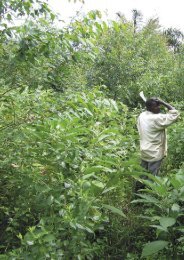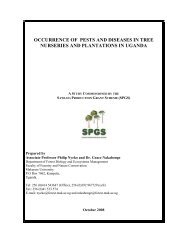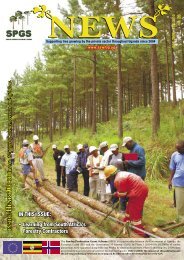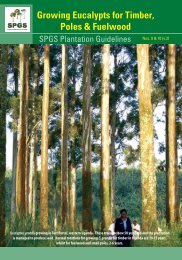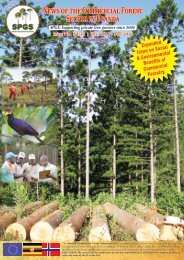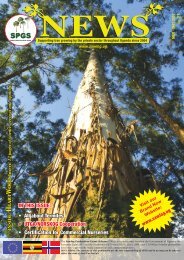1. Why Pine?Pines are generally better suited than most othercommercial tree species, to the grassland anddegraded woodland sites that are mostly availablefor plantation development in Uganda. Many ofthese sites experience hot, dry periods and somehave fairly poor soil. Pines can tolerate suchconditions, provided there is sufficient rootingdepth and moisture in the soil. Some pines (e.g. P.caribaea) have proved to be very adaptable to anumber of sites and soils.Pines are generally well suited to growing in theplantation situation. On good sites, some pinespecies (especially Pinus caribaea var. hondurensis- hereafter referred to as PCH) can grow very fast(e.g. mean annual increments exceeding 30m 3 /ha/yr in Uganda). Most pines also produce a veryversatile, general-purpose timber, which is nowwidely accepted by timber buyers and the Ugandanpublic.In certain areas in Uganda – particularly the bettersites with deep soil and high rainfall – growers couldconsider planting other species for timber (or pole)production: for example, Eucalyptus grandis (whichwill produce timber in considerably less time thanpines); Musizi (Maesopsis eminii) and Hoop Pine(Araucaria cunninghammii). For more informationrefer to the <strong>SPGS</strong> Plantation <strong>Guideline</strong>s No. 5 – TreeSpecies for Commercial Timber Production inUganda and No.9/10 (v.2) – <strong>Gr</strong>owing Eucalypts forTimber, Poles and Fuelwood.2. Pine Species for UgandaThe main pine species for plantations in Uganda arePCH, Pinus oocarpa and Pinus patula. P. patula iseasily identified from the drooping habit of its foliage– hence, its common name of weeping pine. It isnot so easy to tell PCH from P. oocarpa, however,although generally PCH bears its needles in groups(fascicles) of 3, whereas P. oocarpa usually has its ingroups of 5 (be warned though, each species canhave fascicles of 2, 4 or 5!). Young P. oocarpa treesoften appear very bushy for a while after plantingout, with branches sprouting from very low down ontheir stems: this characteristic, however, enables thetrees to re-sprout (coppice) if the plantation getsburnt.Other species have been tried in Uganda but havenot performed well – including, P. radiata and P.kesiya. Other pine species may become availablefor commercial planting in the future – e.g. naturallyoccurring hybrids between PCH and P. oocarpa(which have shown promising ‘hybrid vigour’ in Brazil)and also an artificial cross between PCH and P.elliottii (very successful in Queensland); P. caribaeavar. bahamensis, and better provenances (i.e. seedsources) of P. tecunumanii and P. kesiya – but theseneed to be first planted on a trial basis before wecan confidently recommend them for Uganda’sconditions.3. Species-Site MatchingP. caribaea var. hondurensis (PCH) is a lowlandtropical pine found naturally in Central Americanand the Caribbean basin. In its natural environment,PCH grows best at low altitudes (from sea levelto ca.700m) and on fertile, well drained sites withMean Annual Rainfall (MAR) of 2-3,000mm.PCH - Pinus caribaea var. hondurensis - is by far thepine suited to most sites in Uganda but only useimproved seed – which for many years will haveto be imported.PCH has been extensively planted throughout theAmerican, Asian and African tropics and subtropics,with substantial plantations in Australia, Fiji, Brazil,Venezuala, China and Vietnam. PCH is the mostproductive of the three varieties of P. caribaea (theothers being var. bahamensis and var. caribaea).PCH requires a tropical and humid climate, withMean Annual Rainfall (MAR) of over 1500mm foroptimum growth. PCH can resist moderate droughtsbut shallow soils and very hot, dry sites should beavoided. It grows on wide variety of soil types butrequires a well-drained soil (and at least 600mmrooting depth) for good growth. In Uganda, it growsup at altitudes up to 1500m but prefers the loweraltitudes.P. oocarpa occurs naturally in Mexico and CentralAmerica from 350 to 2500m altitude and with MARof 1000 to 1500mm. As a consequence of its widenatural distribution, P. oocarpa is a very variablespecies, which means that great care has to betaken when introducing it to other countries – ascan be seen from the poor performance of theGood plantation establishment is a combination of careful planning andtiming of silvicultural operations. Follow the recommendations in this<strong>Guideline</strong> to maximize yields and the returns on your investment.
species, particularly in their establishment phase.Pine plantations in Uganda only close their canopiesafter around three years, which has consequencesfor planning silvicultural operations – especiallyweeding. The adoption of the best silviculturalpractices, however, not only speeds up the onset ofcanopy closure but also ensures the highest yieldspossible on the site are obtained. These practicesare a combination of techniques – namely:Fidel Begumisa, a private planter in Kabale (SW Uganda) in his2-yr old Pinus patula stand (established with <strong>SPGS</strong> support). P.patula only grows well in the cool highland areas of Uganda.species in some Ugandan plantings. P. oocarpa isgenerally less productive than P. caribaea, havingslower initial growth and poorer wind-firmness,making it less desirable than PCH. Its lighter crownencourages a weedy under-storey to develop too,which increases the fire risk in plantations.In Uganda, P. oocarpa has traditionally beenrecommended over P. caribaea for higher altitudesites (>1200m) and also sites prone to periodicflooding. Such wet sites should generally be avoidedfor commercial tree planting with any species:additionally the poor form of the locally collected P.oocarpa compared with the improved PCH leadsus to recommend PCH on most other plantingsites. It is hoped to obtain better provenances (i.e.seed origins) of P. oocarpa (and its closely relatedspecies – P. tecunumanii) in the near future but it willobviously a number of years before results from anytrial plantings bear fruit.P. patula is the main commercial timber (and pulp)species in Southern African plantations.P. patula is frequently planted off-site (at lowaltitudes) in Uganda.It is only suited to cooler, moist areas in thesouth-west of Uganda.In Uganda, it is frequently being planted ‘off-site’ (i.e.on sites where it is not adapted to). When plantedon low altitude, hot sites, P. patula does not performwell: it requires high altitude, with a cool and moistclimate. The only region which meets the species’requirements in Uganda, are the highlands in theSouth-West (Kabale).Further details can be found in <strong>SPGS</strong> Plantation<strong>Guideline</strong> No. 6 – Site Species Matching for Uganda’sMain Commercial Tree Species.4. Planning IssuesEven the tropical and sub-tropical pines cultivated inUganda generally grow slower than most Eucalyptus‣ Use of improved seed (preferably seedorchard);‣ good land preparation;‣ timely weed control to minimise competition,especially in the first few years and‣ thinning at the recommended times.NB. Pruning is also recommended but is a qualityissue not directly affecting the plantation yield.The expected rotation for pines grown in Uganda,ranges from 18-25 years. It is feasible for sawlogsto be produced earlier – from thinning operationsat maybe 8-10 years and final crops from 15 yearsonwards – but only on productive sites where heavy,early thinnings have been carried out. With theimbalance in supply and demand predicted forUganda, the actual rotation will undoubtedly bedetermined more by market forces than silviculturalones.An example of good pine (PCH) establishment at the Kasana-Kasambyademonstration plot, near Mubende. This 12 month old crop illustratesappropriate spacing, use of good seed and seedlings, planting at theright time and especially good weeding.The cost for establishing commercial pineplantations in Uganda has been estimated by the<strong>SPGS</strong> to be around Ushs1.2M per hectare: this is anaverage cost across a range of sites in the country.The costs can vary depending on a range of factorsbut especially the optimum timing of operations,the techniques employed for land clearance and US$ 676 at Feb. 2007 exchange rate of 1US$= Ushs1775.



